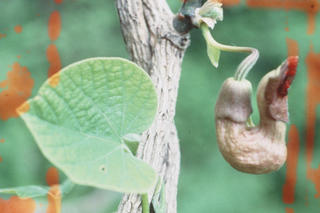Aristolochia manshuriensis
Contents
Nomenclature
Other Names:
Historical Use of Aristolochia manshuriensis
Aristolochia manshuriensis in Traditional Chinese Medicine
Background
Chinese Name (pinyin): Guanmutong
Chinese Name :
Common Name :Manchurian Dutchmanspipe Stem
Specific Name : Caulis aristolochiae manshuriensis
Scientific Name:
Collection : The drug is collected in autumn and winter, remove from coarse bark and dried in the sun.
Description : Long cylindrical, slightly twisted, 1-2m long, 1-6cm in diameter. Externally greyish-yellow or brownish yellow with swallow longitudinal grooves and adhering remains of brown patches of coarse bark. Nodes slightly swollen with a branch scar. Hard and light texture, uneasily broken, fracture yellow or pale yellow, bark narrow, wood broad and exhibiting vessels arranged in many rings, rays radial, pith indistinct. The drug giving off a smell like camphor on rubbing the remains of coarse bark. Odor slight and taste bitter.
Identification : 1. Powder: pale yellow, most fiber tracheids in bundles, long fusiform, 11-20µm in diameter, the walls distinctly bordered pitted, the pit apertures oblique slit or crossed. Septate fibres 21-24 µm in diameter with distinct oblique pits. Stone cells infrequent, subsquare or subpolygonal with relatively thick walls. Clusters of calciums oxalate up to 40µmºººº in diameter. Bordered pitted vessels large up to 328 µm in diameter, mostly broken, bordered pits sorrounded, closely arranged, bordered pitted tracheids infrequent.3. Heat under reflux about 1g of the powder with 20ml of 70% ethanol for 15 minutes, cool and filter. Spot the filtrate on the filter paper, dry it in the air, a sky-blue fluorescence is produced under ultra violet light (365nm), add 1 drop of dilute hydrochloric acid to the spot and dry, a yellowish-green fluorescence is shown, which turns to sky-blue fluorescence again on exposing to ammonia vapour.4. Heat under reflux 1g of the powder with 50ml of ethanol on a water bath for 1 hour and filter. Evaporate the filtrate to dryness and dissolve the residue in 1ml of ethanol as the test solution. Prepare a solution of Caulis Aristolochiae Manshuriensis reference drug in the same manner as the reference drug solution. Dissolve aristolochic acid CRS in ethanol to produce a solution containing 0.5mg per ml as the reference solution. Carry out the method for thin layer chromatography (Appendix Vl B), using silica gel G as the coating substance and upper layer of toluene-ethyl acetate-water-formic acid (20:10:1:1) as the mobile phase. Apply in strips separately to the plate 3µl of the three solutions. After developing and removal of the plate, dry it in the air and examine under the day-light and ultra violet light (365nm) respectively. The strips in the chromatogram obtained with the test solution correspond in the position and colour to the strips in the chromatogram obtained with the reference drug solution and the reference solution repectively.Extractives: Carry out the cold extraction method as described under the determination of water-soluble extractivres (Appendix lX K) not less that 16.0%
Processing : clean wash, soften thoroughly, cut into thin slices and dry in the sun.
Action : To remove heat from the heart, to relieve dysuria and promote diuresis, to stimulate menstrual discharge, and to promote the flow of milk.
Indication : ulcers in the mouth and on the tongue accompanied by fidgets and dark urine; edema, painful difficult urination; excessive leukorrhea; amenorrhea; lack of lactation; acute arthritis due to damp heat
Precautions : Used with caution in pregnancy.
Dosage : 3 to 6 g.
Storage : Preserve in a ventilated dry place.
Synonymns for Aristolochia manshuriensis
Patent Medicines and Medicines with Multiple Ingredients that include Aristolochia manshuriensis
Pharmaceutical Information
Chemical Constituents
Evidence or the Use of Aristolochia manshuriensis in the Treatment of Epilepesy
Basic Science
Animal Studies
Cohort, Case-Control and Non-Randomized Trials
Randomized Controlled Trials
Meta-Analysis
1st Five Results: pubmed search
Yulia A Yugay, Maria R Sorokina, Valeria P Grigorchuk, Tatiana V Rusapetova, Vladimir E Silant'ev, Anna E Egorova, Peter A Adedibu, Olesya D Kudinova, Elena A Vasyutkina, Vladimir V Ivanov, Alexander A Karabtsov, Dmitriy V Mashtalyar, Anton I Degtyarenko, Olga V Grishchenko, Vadim V Kumeiko, Victor P Bulgakov, Yury N Shkryl
##Title##
J Funct Biomater: 2023, 14(9);
[PubMed:37754865]
[WorldCat.org]
[DOI]
(P e)
Yu Cao, Haizhu Shi, Zhuo Lan, Kunlin He, Qian Chen, Chungu Zhang, Shun Feng, Lianhai Shan
##Title##
Anal Methods: 2023, 15(35);4555-4562
[PubMed:37644819]
[WorldCat.org]
[DOI]
(I e)
Yury N Shkryl, Galina K Tchernoded, Yulia A Yugay, Valeria P Grigorchuk, Maria R Sorokina, Tatiana Y Gorpenchenko, Olesya D Kudinova, Anton I Degtyarenko, Maria S Onishchenko, Nikita A Shved, Vadim V Kumeiko, Victor P Bulgakov
##Title##
Int J Mol Sci: 2023, 24(14);
[PubMed:37511000]
[WorldCat.org]
[DOI]
(I e)
Hien Ha Minh, Tram Huynh Ngoc Thuy, Hung Tran Viet
##Title##
Heliyon: 2023, 9(4);e15008
[PubMed:37123914]
[WorldCat.org]
[DOI]
(P e)
Yinsen Song, Zhenzhen Yang, Peipei Wang, Ke Song, Sisen Zhang, Tianli Fan
##Title##
Ann Transl Med: 2022, 10(12);706
[PubMed:35845488]
[WorldCat.org]
[DOI]
(P p)
